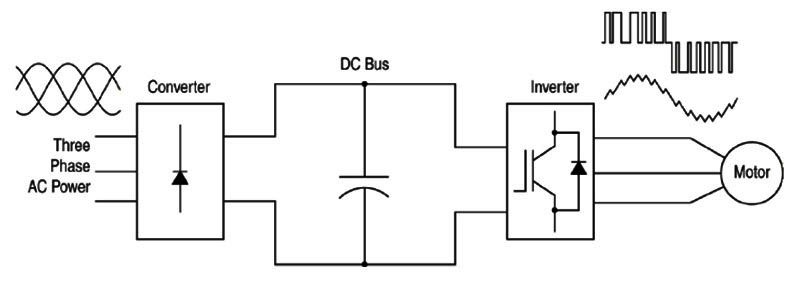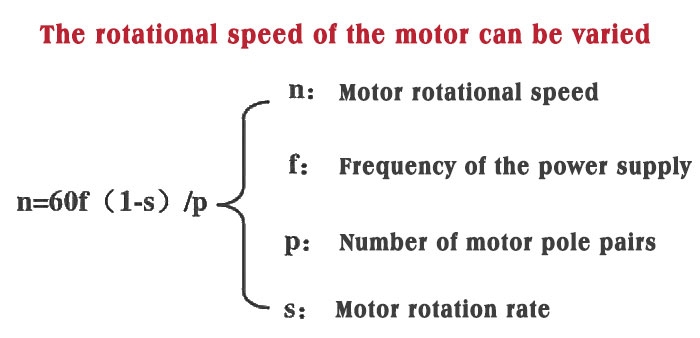The frequency inverter is a power control equipment that applies frequency conversion technology and microelectronics technology to control AC motors by changing the frequency of the motor power supply. Frequency converter relies on the internal IGBT to adjust the voltage and frequency of the output power supply, according to the actual needs of the motor to provide the required power supply voltage, and then achieve the purpose of energy saving and speed regulation. With the increasing degree of industrial automation, frequency inverter has been widely used, Inverter will introduce the basic knowledge of frequency inverter to you.
A frequency inverter is a device that converts industrial frequency power supply (50Hz or 60Hz) into AC power supply of various frequencies to realize the variable speed operation of motors, in which the control circuit completes the control of the main circuit, the rectifier circuit transforms the AC power into DC power, the DC intermediate circuit smoothes and filters the output of the rectifier circuit, and the inverter circuit inverts the DC power back to AC power. For vector control inverters, which require a lot of calculations, a CPU for torque calculation and some corresponding circuits are sometimes required. Inverter speed regulation is achieved by changing the frequency of the power supply to the stator winding of the motor.
Structure of Frequency Inverter
First, the rectifier section converts the AC power supply to DC power. This usually involves a rectifier bridge, which converts the AC voltage to DC voltage. The purpose of the rectifier is to provide a stable DC power source for subsequent circuits. Next comes the filter, whose purpose is to reduce pulsations and harmonics in the DC voltage. Filters usually consist of inductors and capacitors that smooth out the voltage waveforms to ensure stable system operation.
The inverter is the core part of a frequency converter, which converts a DC power supply into an AC power supply with variable frequency and variable amplitude to control the speed of a motor. The inverter uses modern power semiconductor devices such as IGBTs (Insulated Gate Bipolar Field Effect Transistors) or MOSFETs (Metal Oxide Semiconductor Field Effect Transistors) to achieve this power conversion.

Finally, the control circuit is the intelligent part of the inverter, which monitors the motor operating status, receives external input signals, and controls the motor speed and torque by adjusting the output of the inverter. This usually involves PID (Proportional-Integral-Derivative) control algorithms, which are used to precisely regulate the performance of the motor.
Classification of Frequency Inverter
There are various ways to classify inverters. According to the classification of the main circuit working mode, it can be divided into voltage-type inverter and current-type inverter; according to the classification of the switching mode, it can be divided into PAM-controlled inverter, PWM-controlled inverter, and high-load-frequency PWM-controlled inverter. According to the classification of the working principle, it can be divided into V/f control inverter, differential frequency control inverter, and vector control inverter. According to the use classification, it can be divided into general-purpose inverter, high-performance special inverter, high-frequency inverter, single-phase inverter three-phase inverter, and so on.
| Classification | Classification Name | ||
| Main Circuit Working Mode | Voltage type frequency inverter | Current type frequency inverter | |
| Switching Mode | PAM control frequency inverter | PWM control frequency inverter | High-load frequency inverter with PWM control |
| Working Principle | V/f controlled frequency inverter | Differential frequency inverter | Vector control frequency inverter |
| Applications | General purpose frequency inverter | High frequency inverter | Single-phase and three-phase frequency inverter |
Function of Frequency Inverter
- Speed Regulation Function: Frequency converters can change the speed of the motor by adjusting the frequency of the power supply. This is very important for applications that require flexible speed control, such as in industrial production, where different production processes may require different speeds.
- Energy Saving and Consumption Reduction: Frequency inverters achieve effective control of power consumption by adjusting the motor speed. In the case of lighter loads, lowering the motor speed can reduce energy consumption and improve energy utilization efficiency, thus achieving the purpose of energy saving.
- Smooth Starting: The frequency converter can realize the smooth starting of the motor, avoiding the shock and stress that the motor may face during the traditional direct starting, and prolonging the service life of the motor.
- Precise Control: The frequency converter provides precise motor control, and can realize constant speed, timing control, positioning control, and other functions as needed. This is especially important for some systems with high requirements for motion control.
- Reduce Mechanical Loss: By adjusting the speed of the motor, the frequency converter can reduce friction and loss in the mechanical system and improve the efficiency of the system.
- Improve the Quality of Power Grid: when adjusting the motor operation, the frequency converter can reduce the impact of the motor on the power grid, and reduce harmonics and the peak value of the current, which helps to improve the power quality of the power grid.
Frequency Inverter and Energy Saving
The frequency converter is mainly used for AC motor speed regulation, which is recognized as the most ideal and promising speed regulation scheme for AC motors because the frequency converter has a more significant energy-saving effect. The application of frequency conversion speed control can greatly improve the control accuracy of motor speed so that the motor runs at the most energy-saving speed.

First of all, take the fan pump as an example, according to the principle of fluid mechanics, the shaft power is proportional to the third power of the rotational speed. When the required air volume is reduced, fan speed is reduced, and its power is by the cubic decline, therefore, the power-saving effect of precise speed control is very significant. Secondly, similar to this, many variable load motors are generally produced according to the maximum demand for motor capacity, so the design margin is large. In actual operation, the proportion of light-load operation time is very high, and the use of frequency conversion speed control can greatly improve the efficiency of light-load operation. Therefore, the energy-saving potential of variable load motors is huge.
Direct starting of the motor at industrial frequency will produce a large starting current. When using a frequency converter, the output voltage and frequency of the frequency converter are gradually added to the motor to play a role in limiting the starting current to less than the rated current, so the starting current and impact are smaller, which can reduce the wear and tear on the equipment.
Advantages of Frequency Inverter
- Improvement of Energy Efficiency: Frequency converter can adjust the running speed of the motor to make it match the load requirement, to effectively improve energy efficiency. When the load is light, reducing the motor running speed can reduce energy consumption and improve the overall efficiency of the system.
- Precise Control: The frequency converter can realize precise control of the motor speed so that it can adapt to different working conditions. This precise control helps to improve the stability and reliability of the production process.
- Smooth Starting: Compared with the traditional direct starting method, the frequency converter can realize the smooth starting of the motor, reduce the impact and loss during starting, and prolong the life of the motor.
- Energy Saving and Emission Reduction: Due to the ability to adjust the running speed of the motor according to the need, the frequency converter helps to reduce the energy consumption of the system and minimize the waste of energy, thus reducing the carbon emission and conforming to the requirement of sustainable development.
- Reducing Equipment Loss: By reducing the running speed of the motor in the non-operating state, the frequency converter can reduce the mechanical loss of the equipment and prolong the service life of the equipment.
- Versatility: The Inverter can adapt to various application scenarios, widely used in industrial production, manufacturing, air conditioning, water pumps, fans, and other fields, providing flexible control solutions for different systems.
- Reduced Mechanical Shock: The frequency converter reduces the mechanical shock in the system by smoothly adjusting the running speed of the motor, which helps to improve the stability and reliability of the equipment. Helps to improve the stability and reliability of the equipment.
In the continuous evolution of frequency converter technology, frequency converter has become an indispensable and important part of the industrial automation field. By realizing variable speed control of motors, frequency converters play a key role in improving production efficiency, saving energy reducing consumption, and reducing equipment loss. With the development of intelligence and digitalization, the frequency converter not only stays in the traditional level of motion control but also gradually integrates into the industrial Internet, big data, and other advanced technologies to realize a higher level of automation and intelligent management.
